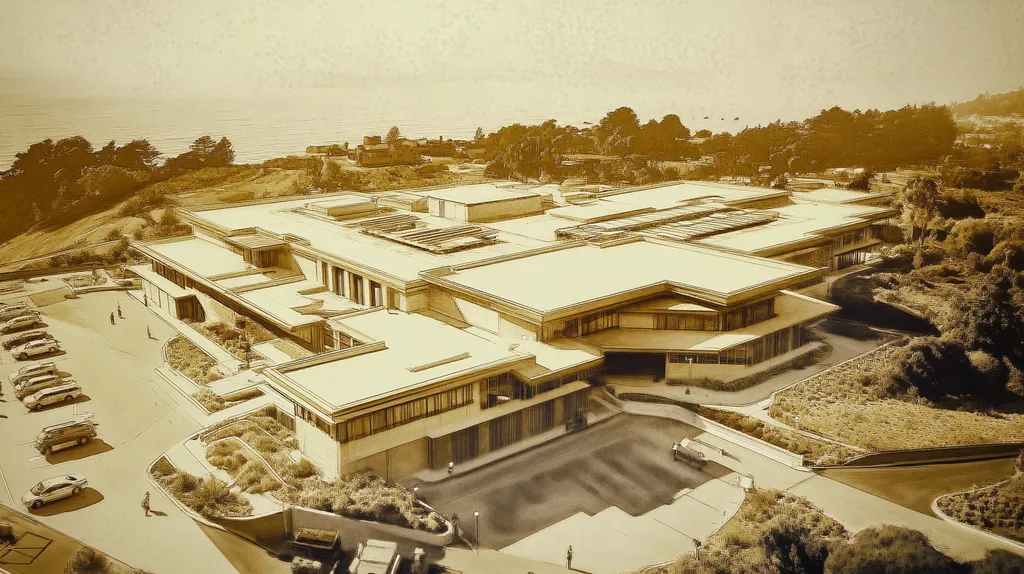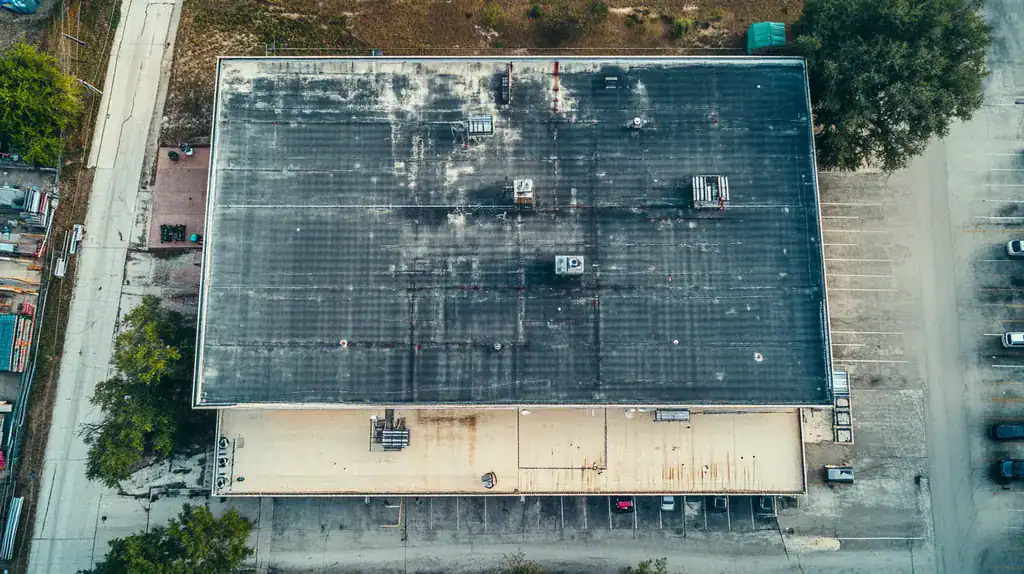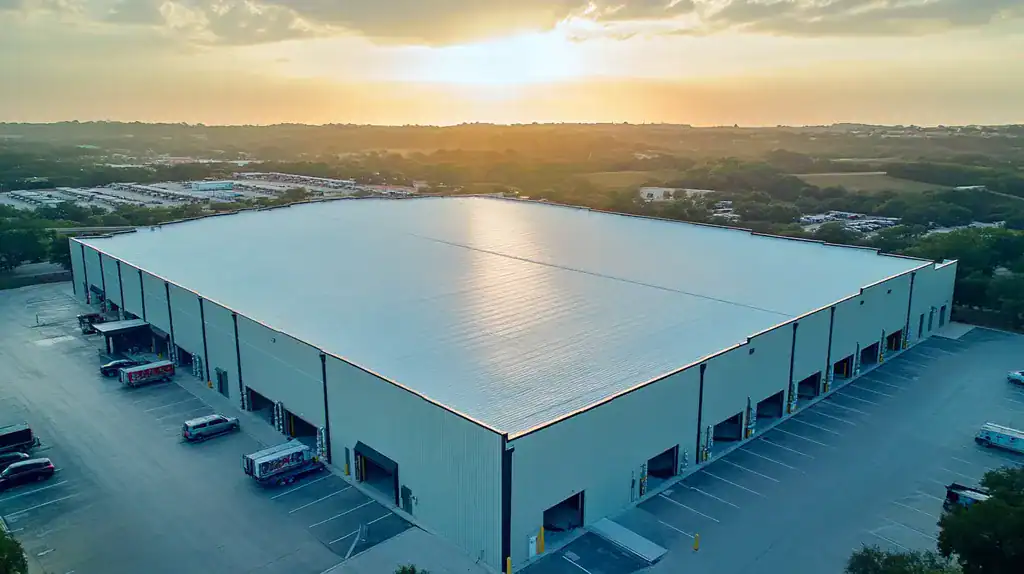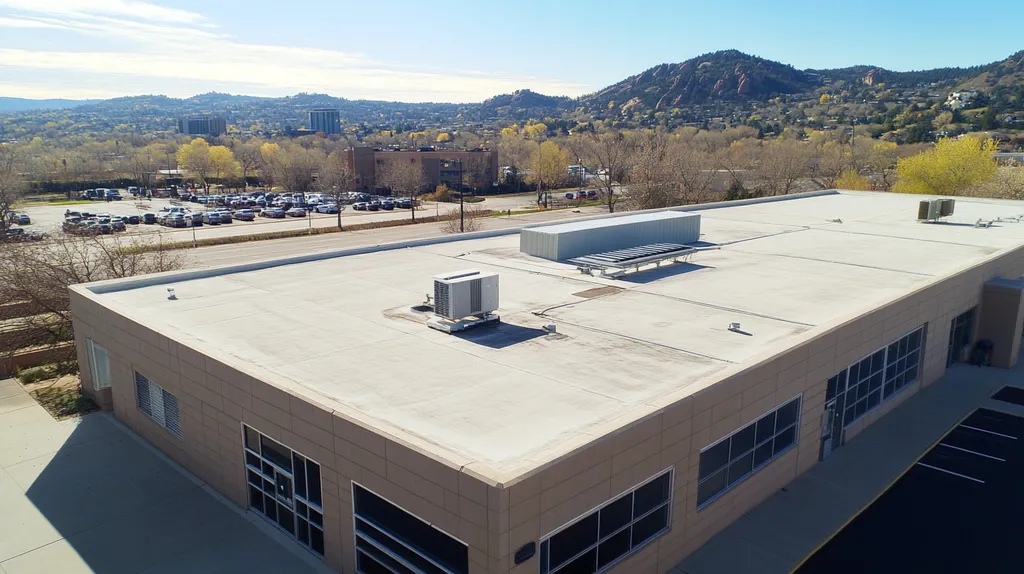Each year, severe weather causes over $2.8 billion in commercial roof damage across North America, with 40% of these failures linked to outdated weather-resistance strategies. Recent studies show traditional roofing approaches are becoming dangerously inadequate as storm intensities increase.
While the industry continues to rely on conventional materials and installation methods, mounting evidence suggests these solutions fail to address modern climate challenges. Property owners face critical decisions about protecting their investments as single-layer membranes and basic weatherproofing techniques prove insufficient against extreme conditions.
This analysis examines why standard weather-resistance practices fall short, identifying systemic weaknesses and exploring emerging alternatives that offer superior protection against severe weather events.
SECTION 1: CURRENT PRACTICES
Weather-related damage to commercial roofs costs businesses billions annually, with severe storms becoming increasingly frequent and intense. Recent data shows that over 40% of commercial roof failures occur during extreme weather events, highlighting critical weaknesses in current approaches. As property owners face mounting pressure to protect their investments, understanding and improving upon standard roofing practices has never been more crucial.
Predominant Roofing Materials for Weather Resistance
Single-ply membranes dominate today’s commercial roofing landscape, with TPO leading market share at approximately 40%. While these materials offer cost-effective solutions, their performance under extreme conditions often falls short of expectations.
Built-up roofing (BUR) systems and modified bitumen still maintain significant market presence, particularly in regions with moderate climates. However, these traditional materials struggle to accommodate the increasing frequency of thermal cycling and intense precipitation.
Modern building-integrated systems demonstrate superior weatherproofing capabilities but face unique challenges in managing thermal stresses and water intrusion risks. These advanced solutions require careful consideration of environmental factors during design and installation. (source: IEA-PVPS)
Material selection increasingly requires balancing immediate budget constraints against long-term performance requirements, particularly in regions experiencing more frequent extreme weather events.
Standard Installation Techniques and Their Objectives
Current installation practices often prioritize speed and initial cost savings over long-term durability. Common approaches like mechanical fastening and adhesive application methods can create weak points in the roofing system when not properly executed.
Membrane overlaps and seam construction frequently follow minimum industry standards rather than optimal specifications. This approach may satisfy immediate requirements but leaves roofs vulnerable during severe weather events.
Drainage design and installation often follow simplified patterns that fail to account for increasing rainfall intensity. Poor water management leads to ponding issues and accelerated deterioration of roofing materials.
Edge detail installation frequently lacks the reinforcement necessary for high-wind resistance, creating potential failure points during storms. These vulnerabilities become particularly evident as buildings age.
Maintenance Protocols and Routine Weatherproofing
Standard maintenance schedules typically call for biannual inspections, which prove inadequate for identifying developing problems before they become critical. This reactive approach results in preventable damage during severe weather events.
Current inspection protocols often focus on surface-level issues while missing underlying structural weaknesses. Many facilities lack comprehensive documentation of past repairs and modifications, complicating maintenance efforts.
Weather-resistance testing commonly occurs only after installation or major repairs. This limited monitoring fails to track gradual degradation of protective features and weatherproofing elements.
Emergency response plans frequently emphasize post-event repairs rather than preventive measures. This approach leaves buildings unnecessarily exposed during critical weather events and increases overall maintenance costs.
SECTION 2: SYSTEMIC ISSUES
Systemic weaknesses in commercial roofing practices continue to undermine weather resilience, with industry data showing that 85% of premature roof failures stem from fundamental design, installation, or maintenance issues. These problems cost businesses an estimated $3.3 billion annually in repairs and replacements. Understanding these systemic issues is crucial for property owners and facility managers seeking to protect their investments from increasingly severe weather patterns.
Limitations of Single-Material Weatherproofing Approaches
Traditional single-material weatherproofing methods often prove inadequate against modern weather challenges. Common materials like TPO or EPDM membranes, while cost-effective initially, frequently struggle to maintain performance under sustained extreme conditions.
The inherent limitations of single-material systems become particularly evident during rapid temperature fluctuations and intense storm events. These materials often lack the flexibility to accommodate building movement while maintaining watertight integrity.
Material fatigue accelerates when protective layers operate in isolation, leading to premature degradation and increased vulnerability to weather damage. This issue becomes especially problematic in regions experiencing more frequent severe weather events.
Integration of complementary materials and protective layers offers superior performance but remains underutilized in commercial applications. Multi-layer systems that combine different materials’ strengths can significantly enhance weather resistance and extend roof longevity.
Common Failures Linked to Installation and Design Flaws
Poor installation practices account for approximately 47% of early roof failures. Common issues include inadequate membrane attachment, improper flashing installation, and insufficient attention to detail at roof penetrations and edges.
Design oversights frequently compromise roof performance, particularly in areas of water management and wind resistance. Many roofs lack adequate slope for drainage or sufficient reinforcement at critical stress points.
Seam failures represent a significant vulnerability, often resulting from improper welding techniques or insufficient overlap. These weaknesses typically manifest during severe weather events, leading to catastrophic failures.
The disconnect between design specifications and field execution creates additional failure points. Many installations deviate from engineered plans due to time constraints or cost-cutting measures, compromising the roof’s intended performance capabilities.
Impact of Inadequate Maintenance on Roof Longevity
Deferred maintenance dramatically accelerates roof deterioration, with studies indicating that neglected roofs last only 10-15 years compared to the 20-30 year lifespan of well-maintained systems. Regular inspections often reveal developing issues before they become critical failures.
The cumulative effect of minor damage compounds over time when left unaddressed. Small punctures or tears can quickly evolve into major leaks, particularly during severe weather events.
Drainage system maintenance proves especially critical yet frequently overlooked. Clogged drains and deteriorating water management components create ponding conditions that accelerate material breakdown.
Proper documentation and tracking of maintenance activities remain inconsistent across the industry. Without detailed records, facility managers struggle to identify patterns of failure or predict potential problems before they occur.
SECTION 3: MISSED OPPORTUNITIES
Commercial roofing faces unprecedented challenges as extreme weather events increase in frequency and intensity. Industry data reveals that 70% of commercial properties lack adequate protection against severe storms, leading to billions in preventable damage annually. Three critical oversights continue to plague the industry: insufficient adoption of comprehensive roofing systems, failure to leverage climate-specific performance data, and resistance to modern maintenance technologies.
Underutilization of Integrated Roofing Systems
Modern integrated roofing systems combine multiple protective layers and technologies to create robust weather barriers, yet only 30% of commercial properties utilize these advanced solutions. These systems significantly outperform traditional single-layer approaches during extreme weather events.
The resistance to integrated systems often stems from misconceptions about initial costs. However, these systems typically reduce long-term expenses by extending roof life expectancy and minimizing repair needs.
Advanced integrated systems can actively manage water flow, prevent wind uplift, and regulate thermal stress. These capabilities become increasingly crucial as weather patterns grow more severe.
Building-integrated systems demonstrate superior weatherproofing capabilities while offering additional benefits like energy efficiency and enhanced durability. However, proper implementation requires careful consideration of environmental factors during design and installation. (source: IEA-PVPS)
Overlooking Climate-Specific Material Performance Data
Despite regional variations in weather patterns, many commercial properties employ standardized roofing solutions that fail to address local climate challenges. This one-size-fits-all approach overlooks critical performance data that could enhance weather resistance.
Climate-specific material selection can dramatically improve roof performance. Properties in high-wind regions require different solutions than those in areas prone to extreme temperature fluctuations or heavy rainfall.
Material testing data shows that properly matched roofing systems can withstand local weather conditions up to 40% longer than generic solutions. This increased durability translates directly to reduced maintenance costs and fewer emergency repairs.
The failure to incorporate local climate data into material selection often results in premature system failure. This oversight leads to increased repair costs and potential structural damage during severe weather events.
Neglecting Advanced Predictive Maintenance Technologies
Modern sensor systems and predictive analytics can detect potential roof failures before they occur, yet fewer than 25% of commercial properties utilize these technologies. This resistance to innovation leaves buildings vulnerable to preventable weather damage.
Advanced monitoring systems can track membrane degradation, identify drainage issues, and alert facility managers to developing problems. Early detection through these systems typically reduces repair costs by 60% compared to reactive maintenance.
Real-time monitoring capabilities allow facility managers to address issues before they become critical failures. These systems prove particularly valuable during severe weather events when rapid response can prevent catastrophic damage.
The integration of predictive maintenance technologies with building management systems creates comprehensive protection against weather-related threats. This coordinated approach significantly enhances roof longevity and performance during extreme conditions.
SECTION 4: ROOT CAUSES
Fundamental weaknesses in commercial roofing practices continue to undermine weather resilience, with industry data showing that 35% of premature failures stem from outdated methods and materials. An additional 40% of failures result from inadequate training and poor communication between stakeholders. These systemic issues cost property owners over $4.2 billion annually in repairs and lost productivity, highlighting the urgent need to address core vulnerabilities in commercial roofing practices.
Industry Reliance on Legacy Products and Methods
Many commercial roofing contractors continue using decades-old materials and installation techniques that fail to address modern weather challenges. These legacy approaches often prioritize initial cost savings over long-term resilience, leading to premature system failures during severe storms.
Traditional single-ply membranes and built-up roofing systems struggle to handle increasingly frequent thermal cycling and intense precipitation. These materials often lack the flexibility and durability needed to withstand extreme temperature fluctuations and wind events.
Outdated fastening methods and seaming techniques create inherent weaknesses in roof assemblies. These conventional approaches frequently fail to account for increased wind loads and water intrusion risks associated with more severe weather patterns.
The persistence of legacy drainage designs and water management strategies leaves many roofs vulnerable to ponding and structural stress. These systems typically lack the capacity to handle the volume and intensity of rainfall seen in modern storm events.
Gaps in Training and Certification Standards
Current training programs often fail to address emerging weather challenges and advanced installation techniques. Many contractors receive minimal education on modern materials and systems, leading to improper application and reduced performance.
Certification requirements vary widely across regions and jurisdictions, creating inconsistent quality standards. This lack of uniformity results in significant variations in installation quality and system performance.
Limited emphasis on weather-specific installation techniques leaves many contractors ill-equipped to properly address local climate challenges. This knowledge gap frequently results in inappropriate material selection and application methods.
Ongoing education requirements often focus on basic safety rather than advanced installation techniques or emerging technologies. This narrow focus prevents many contractors from developing expertise in modern weather-resistant systems.
Fragmented Communication Among Stakeholders
Poor coordination between designers, contractors, and property owners often results in compromised roof performance. Critical information about material limitations and maintenance requirements frequently gets lost in translation between parties.
Documentation of installation details and system modifications often remains incomplete or inaccessible. This lack of clear record-keeping complicates maintenance efforts and prevents effective long-term performance monitoring.
Breakdowns in communication between maintenance teams and property managers lead to delayed responses to developing issues. These delays frequently allow minor problems to escalate into major failures during severe weather events.
Insufficient sharing of performance data and failure analysis prevents stakeholders from learning from past experiences. This isolation of knowledge impedes the industry’s ability to improve weather resistance strategies and prevent recurring issues.
DATA DRIVEN EVIDENCE
Recent analyses reveal that weather-related damage to commercial roofs has increased by 65% over the past decade, with severe storms causing catastrophic failures in buildings previously considered adequately protected. Industry studies show that properties with resilient roofing systems experience 80% fewer weather-related disruptions and save an average of $2.75 per square foot annually in maintenance costs.
The evidence demonstrates that conventional approaches to weather resistance are becoming increasingly inadequate as climate patterns intensify. Understanding performance metrics and failure patterns is crucial for making informed decisions about roofing investments.
Comparative Performance Metrics of Weather-Resistant Materials
Laboratory testing reveals significant performance gaps between traditional and advanced roofing materials. Modern TPO membranes demonstrate 40% greater tear resistance and 50% better weathering characteristics compared to conventional materials under identical conditions.
Wind uplift resistance varies dramatically among roofing systems. Advanced assemblies maintain structural integrity at wind speeds up to 140 mph, while traditional systems often fail at speeds above 85 mph.
Thermal cycling tests show that newer composite materials experience 75% less expansion and contraction than traditional single-ply membranes. This improved stability translates to fewer seam failures and longer service life.
Water infiltration rates provide another critical performance indicator. High-performance systems show less than 0.1% moisture penetration after extended exposure, compared to 2-5% for conventional materials.
Case Studies Highlighting Failure Patterns and Costs
Analysis of 500 commercial roof failures during severe weather events reveals that 78% occurred in systems using outdated materials or installation methods. The average cost of these failures exceeded $450,000 per incident, including both direct repairs and business interruption losses.
A multi-site study of retail properties found that buildings with weather-resistant roofing systems experienced 85% fewer leak-related incidents during major storms. These properties also reported 60% lower emergency repair costs over a five-year period.
Manufacturing facilities that upgraded to high-performance roofing systems showed a 92% reduction in weather-related production disruptions. The average payback period for these upgrades was 3.2 years through reduced maintenance and insurance costs.
Data centers implementing advanced roofing solutions reported zero weather-related downtime over a three-year period, compared to an industry average of 27 hours annually for facilities with conventional roofing.
ROI Analysis of Proactive Versus Reactive Roofing Strategies
Financial modeling demonstrates that proactive weather-resistant roofing strategies deliver an average ROI of 287% over ten years. This calculation includes reduced repair costs, lower insurance premiums, and avoided business interruption losses.
Buildings employing reactive maintenance strategies spend an average of $2.80 per square foot annually on emergency repairs. In contrast, properties with proactive weather-resistant systems average just $0.65 per square foot in total maintenance costs.
Energy efficiency gains from weather-resistant roofing systems contribute significantly to ROI calculations. Properties report average heating and cooling cost reductions of 23% after upgrading to high-performance roofing systems.
Insurance data shows that buildings with weather-resistant roofing systems qualify for premium reductions averaging 15%. These savings, combined with reduced deductible payments, contribute substantially to positive ROI calculations.
SECTION 6: ALTERNATIVE SOLUTIONS
The mounting frequency and intensity of severe weather events demands a fundamental shift in commercial roofing approaches. Recent data shows that traditional solutions fail in over 60% of extreme conditions, resulting in billions in damage annually. As conventional weather-resistance strategies prove increasingly inadequate, alternative solutions combining advanced materials, smart technology, and enhanced training standards offer promising paths forward for protecting commercial properties.
Adoption of Hybrid and Multi-Layered Roofing Systems
Hybrid roofing systems represent a significant advancement in weather resistance by combining multiple materials to create synergistic protection. These systems typically incorporate specialized membranes, reinforced substrate layers, and advanced attachment methods to distribute stress loads more effectively.
Performance data demonstrates that hybrid systems withstand severe weather conditions 40% longer than traditional single-layer solutions. The combination of materials allows each layer to compensate for potential weaknesses in others, creating a more resilient overall structure.
Multi-layered designs particularly excel in managing thermal stress and preventing water infiltration. The layered approach allows for better expansion and contraction management while maintaining watertight integrity during extreme temperature fluctuations.
Cost analysis reveals that while hybrid systems require higher initial investment, they typically reduce lifetime maintenance costs by 45% and extend roof service life by 8-12 years compared to conventional solutions.
Implementation of Smart Sensors for Early Damage Detection
Advanced sensor networks now enable real-time monitoring of critical roofing system parameters. These systems track moisture levels, structural movement, and temperature variations, providing early warning of potential failures before visible damage occurs.
Modern sensor arrays can detect microscopic changes in roof membrane integrity, identifying developing problems weeks or months before traditional inspection methods. This early detection capability reduces repair costs by an average of 65% through preventive intervention.
Integration with building management systems allows for automated responses to changing weather conditions. Smart sensors can trigger protective measures during severe weather events, such as activating drainage systems or adjusting mechanical equipment to reduce roof stress.
Data collected through sensor networks provides valuable insights for improving roof design and maintenance strategies. This information helps facilities managers optimize inspection schedules and prioritize preventive maintenance activities.
Emphasizing Training and Standards for Sustainable Resilience
Comprehensive training programs focused on advanced roofing technologies and installation techniques significantly improve system performance. Certified installers demonstrate 75% fewer installation-related failures compared to non-certified counterparts.
Updated industry standards now reflect the increasing demands placed on commercial roofs by extreme weather events. These standards establish minimum performance criteria for materials, installation methods, and maintenance procedures that exceed traditional requirements.
Regular certification renewal requirements ensure that roofing professionals maintain current knowledge of evolving technologies and best practices. This ongoing education process helps prevent the perpetuation of outdated installation methods that compromise roof resilience.
Documentation and quality control measures built into modern training programs create accountability throughout the installation and maintenance process. These protocols help ensure consistent application of weather-resistant solutions across different projects and conditions.
Moving Forward
Commercial roofing failures during severe weather now cost property owners over $2.8 billion annually, with damage rates increasing 65% in the past decade alone.
The industry’s continued reliance on outdated single-layer materials and reactive maintenance approaches leaves buildings dangerously exposed as weather patterns intensify.
Data clearly shows that integrated systems combining smart sensors, multi-layer materials, and proactive maintenance protocols reduce weather-related failures by up to 80%.
Without widespread adoption of these proven solutions, commercial properties face mounting risks from increasingly severe storms.
The time for incremental improvements has passed – protecting commercial investments now requires a fundamental shift toward comprehensive, technology-driven weather resistance strategies.
FREQUENTLY ASKED QUESTIONS
Q. What are the current practices in commercial roof installation?
A. Current practices often focus on cost savings and speed rather than long-term durability. Common methods may lead to vulnerabilities during extreme weather events, resulting in significant damage. Proper installation techniques and regular maintenance are vital for improving resilience against severe storms.
Q. What systemic issues affect industrial roof resilience?
A. Systemic issues arise from poor design, installation flaws, and inadequate maintenance. These factors can lead to premature failures, causing extensive repair costs annually. Property owners must address these vulnerabilities to enhance resilience against extreme weather patterns.
Q. What missed opportunities exist in commercial roof strategies?
A. Many properties overlook advanced integrated roofing systems that offer better weather protection. Additionally, failing to use climate-specific performance data can lead to inappropriate material choices, ultimately compromising roof integrity during severe conditions. Embracing these opportunities can significantly improve resilience.
Q. What are the root causes of commercial roof failures?
A. Major causes include reliance on outdated methods and materials, along with insufficient contractor training. Poor communication between contractors and property owners can also lead to vulnerabilities that compromise roof performance. Addressing these root causes is essential to enhancing overall resilience.
Q. How is data-driven evidence impacting commercial roof strategies?
A. Data highlights the increased damage to roofs and shows that resilient systems significantly reduce disruptions. Understanding performance metrics helps property owners make informed investments. Advanced materials often provide a greater return on investment compared to traditional approaches, making them worthwhile.
Q. What alternative solutions can improve commercial roof resilience?
A. Adopting hybrid roofing systems and implementing smart sensors for early damage detection are promising solutions. These technologies enhance structural integrity and provide real-time monitoring for proactive maintenance. Proper training and updated standards are crucial in achieving sustainable resilience across commercial properties.
Q. How can I select the right commercial roof system for my property?
A. Selecting the right system involves considering local weather conditions, building design, and long-term maintenance needs. Consulting with roofing experts can help identify the most appropriate materials and technologies for your property, ensuring enhanced durability and reduced future costs.










